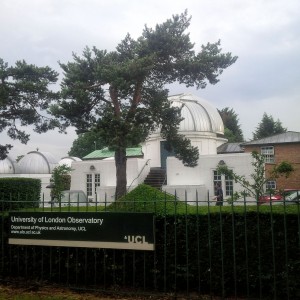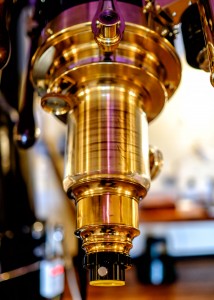June 20, 2015
Trip to the University of London Observatory
Report by Mike Meynell
As the main Flamsteed season comes to an end, the month of June has traditionally become a time when we try to arrange trips to sites that are of interest to our members. We were in the fortunate position this year of being able to arrange a tour of the University of London Observatory (ULO) at Mill Hill, in the company of one of the people who helped to form the Flamsteed Astronomy Society back in 1999, Dr Francisco Diego of UCL.
The observatory was opened back in 1929 by the Astronomer Royal, Sir Frank Dyson, and was originally established as a facility for the use of the University of London. Since 1951, however, it has been exclusively managed by University College London (UCL), but the “University of London Observatory” name is still used. Nowadays, the observatory is used to teach first and third year undergraduate students from UCL, as well as those taking the UCL Certificate of Higher Education in Astronomy. Recently, on 21 January 2014, Dr Steve Fossey, along with a team of students, discovered Supernova SN2014J in galaxy M82 using one of the Celestron C14 telescopes at ULO. The observatory is now equipped with five permanently mounted telescopes.
We started our tour with a brief introduction from Francisco, and then a short chat with Yvonne Darby, Roderick O’Sullivan and John Hodson; three students who are taking the 2-year certificate, about their experiences at the observatory. Very kindly, Yvonne, Roderick and John had also given up their afternoon to help take us around the observatory.
After this introduction, we split into groups for our tour. In my group, our first stop was to view the Radcliffe Telescope. This is a twin refractor, originally built by Grubb of Dublin in 1901, and made for the Radcliffe Observatory in Oxford. It was offered to ULO in 1935 and erected at Mill Hill in 1938, and consists of an 18-inch and 24-inch refractor on a German Equatorial Mount. Unfortunately for us, the telescope was covered in plastic, as the dome was currently being cleaned and refurbished. However, it was still possible to appreciate the scale of the telescope. The floor of the telescope dome raises and lowers to ease observation. One of the scopes has an eyepiece and the other is connected to a CCD camera. The telescope and counterbalance weigh about 5 tonnes and it was a very impressive sight, even though it was covered in polythene! The scope is principally used for undergraduate research.
Next up was my favourite telescope of the tour… the Fry telescope. Built in 1862, this is an 8-inch f/16 refractor, made by Thomas Cooke of York. The telescope was donated to the ULO by Mr H.R. Fry of Barnet, hence the name the “Fry Telescope”. The telescope was fully refurbished between 1982 and 1997, and looks absolutely stunning – almost like new. The mount uses a weight-driven clockwork drive with lead weights attached. The telescope is beautifully designed and it is great to see such an historic telescope still being used for practical observing.
Within the same building are housed the two Celestron C14 telescopes. Each are installed on robotic mounts, enabling remote access to the telescopes. One of these telescopes was used in the discovery of the Supernova in January 2014, as noted above. Both are superb instruments and have large CCD cameras attached.
Finally, we went to see the Allen Telescope, which is a 24-inch reflector of Ritchey-Chretien design on a German Equatorial mount. Built in 1974, this telescope has a spectrograph attached. The spectrograph is calibrated using copper-argon or iron-neon lamps. The telescope does have the ability for a Coude focus, but this isn’t currently used. The Allen Telescope is primarily used by third-year undergraduates for taking spectrums of stars. Francisco kindly showed us some of the diffraction gratings used within the spectrograph.
Thank you to all who attended, and, in particular, our sincere thanks to Dr Francisco Diego, Yvonne Darby, Roderick O’Sullivan and John Hodson for a fascinating and most enjoyable tour.
Pictures from the Trip (by Mike Meynell and Andy Sawers):
Posted under: Flamsteed, Society Trip

























You must be logged in to post a comment.